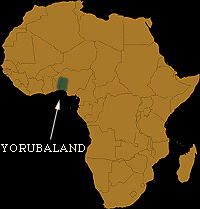|
To look at
the roots of Santería is to gaze into Africa's past
and, more specifically, the people that are known
collectively as the Yoruba. History tells us
that the Yoruba, like the many other cultures of
Africa, are rich and complex. They possess a
"tradition of urban life" achieved before
European contact and "in economics,
government, and in particular art and religion, they
rank with those other West African groups which
represent the highest level of cultural achievement
in sub-Saharan Africa" (Bascom 1961:1, Brandon
1993:20). Simply
put, the Yoruba, shatter the European perception
that the people of Africa were savages. To
discuss the multitude of aspects relating to the
Yoruba would be a considerable undertaking.
Their history alone is, as one might expect,
extensive. Instead on focusing on such a broad
topic, I will look at the history and religion of the Yoruba
primarily as it relates to their contribution to the
rise and spread of the religion we know
today as Santería.

The lands of the Yoruba are
located in modern day Nigeria.
Map sourced from
http://www.batadrums.com/background/yorubmap.gif.
In Santería from Africa to the
New World, I believe that George Brandon sums
the concept of religion for the Yoruba succinctly:
The
African religions of the area are human centered
but posses an idiom of embracing all of life.
The happy, prosperous passage of humans through
this world and the spectacle of curing and
immortality are their major concerns, not
salvation. They sanctify nature, cultural
production and human relations as modes and
means of divinity. Integral and diffuse,
they penetrate everyday life with a distinctive
attitude towards existence (1993:30).
For the Yoruba,
religion wasn't simply a practice. It was a
way of life that permeated through everything that
they touched. Their view is one which remains
in harmony with nature, maintaining a healthy
respect living things in their many forms, no matter
how small or inconsequential. Why?
Because the Yoruba believe that all living things
have ashé.
Ashé is ever
present and vital. In his book Santería, Miguel De
La Torre describes ashé as “a sort of primal energy
that comprises the power, grace, blood, and life
force of all reality. It is amoral, neither good nor
bad, unable to be seen or personified, a neutral
cosmic energy undergirding every aspect of
existence” (2004:22). The concept of ashé is a
powerful one and humbling as well. It
demonstrates the great degree of complexity and
understanding these "savages" had.
Ancestor worship is also a
crucial element in this system of beliefs.
Family was of great importance to the Yoruba.
Individuals were tied to their roots through their
ancestry. Those who came before provide
lessons , assistance and guidance for those who
remain and must be given accord as a result.
The Yoruba call their ancestors ara orun,
meaning "people of heaven" (Murphy 1993:8-9).
Ceremonies always include some form of veneration to
the ara orun, and there are annual celebrations held
in their honor.
One cannot discuss the religion
of the Yoruba without taking into consideration the
orishas, the deities that make up the Yoruba
pantheon. It is believed that all of the
orishas came from a single entity or "god" call
Olodumare or Olofi. I have heard in stories,
called patakis, that one can imagine the
Yoruba pantheon to be like a great tree.
Olodumare is the root of the tree who gives rise to
the orishas. The trunk of the tree might be
thought of as Yemaya, considered the mother of the
orishas, or Obatala who rules all heads. There
are hundreds of orishas, but there are only a few
that are worshipped more universally. They
include: Eleggua who opens the way, Ogun who is
associated with iron, Babalu Ayé who is associated
with sickness and healing, Oya who rules over the storms,
Shangó, the proud warrior
king and lord of thunder, Oshun who is associated
with rivers, and Ochosi the hunter.
Individuals may be initiated into
the religion through a ritual that takes seven days.
The initiate dies to the person they were and is
reborn into a new life through the orisha.
Elements of the ceremony incorporate ebbo, sacrifice. The
orishas must be fed and nourished with ashé, and
this is accomplished through animal sacrifice in the
case of initiations and some offerings.
Temples were built to house the
objects associated with a particular orisha.
The priests that have been initiated or "crowned"
with that orisha will work in service of that
orisha. According to William Bascom, "An
individual normally worships the deity of his
father, and some also worship their mother's deity
as well. Many deities are identified with a
particular clan in which case all members, male and
female, are worshipers by virtue of birth into it"
(1969:77). In this respect, worship is
intimately related with ones family ties.
Other ties would be broken,
though, when civil war tore apart alliances.
Raids on villages saw the taking of thousands as
slaves to be shipped off to the New World. The
first African slaves would arrive in Cuba in 1511;
however, it would not be until the 19th Century when
the sugar and tobacco boom would begin bringing in
the largest number of slaves to the Spanish
controlled island. |